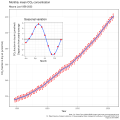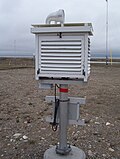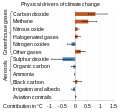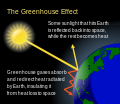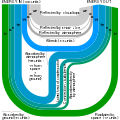Portal:Climate change
The Climate Change Portal Present-day climate change includes both global warming—the ongoing increase in global average temperature—and its wider effects on Earth’s climate system. Climate change in a broader sense also includes previous long-term changes to Earth's climate. The current rise in global temperatures is driven by human activities, especially fossil fuel burning since the Industrial Revolution. Fossil fuel use, deforestation, and some agricultural and industrial practices release greenhouse gases. These gases absorb some of the heat that the Earth radiates after it warms from sunlight, warming the lower atmosphere. Carbon dioxide, the primary gas driving global warming, has increased in concentration by about 50% since the pre-industrial era to levels not seen for millions of years. Climate change has an increasingly large impact on the environment. Deserts are expanding, while heat waves and wildfires are becoming more common. Amplified warming in the Arctic has contributed to thawing permafrost, retreat of glaciers and sea ice decline. Higher temperatures are also causing more intense storms, droughts, and other weather extremes. Rapid environmental change in mountains, coral reefs, and the Arctic is forcing many species to relocate or become extinct. Even if efforts to minimize future warming are successful, some effects will continue for centuries. These include ocean heating, ocean acidification and sea level rise. Climate change threatens people with increased flooding, extreme heat, increased food and water scarcity, more disease, and economic loss. Human migration and conflict can also be a result. The World Health Organization calls climate change one of the biggest threats to global health in the 21st century. Societies and ecosystems will experience more severe risks without action to limit warming. Adapting to climate change through efforts like flood control measures or drought-resistant crops partially reduces climate change risks, although some limits to adaptation have already been reached. Poorer communities are responsible for a small share of global emissions, yet have the least ability to adapt and are most vulnerable to climate change. Many climate change impacts have been observed in the first decades of the 21st century, with 2024 the warmest on record at +1.60 °C (2.88 °F) since regular tracking began in 1850. Additional warming will increase these impacts and can trigger tipping points, such as melting all of the Greenland ice sheet. Under the 2015 Paris Agreement, nations collectively agreed to keep warming "well under 2 °C". However, with pledges made under the Agreement, global warming would still reach about 2.8 °C (5.0 °F) by the end of the century. Limiting warming to 1.5 °C would require halving emissions by 2030 and achieving net-zero emissions by 2050. There is widespread support for climate action worldwide. Fossil fuel use can be phased out by conserving energy and switching to energy sources that do not produce significant carbon pollution. These energy sources include wind, solar, hydro, and nuclear power. Cleanly generated electricity can replace fossil fuels for powering transportation, heating buildings, and running industrial processes. Carbon can also be removed from the atmosphere, for instance by increasing forest cover and farming with methods that capture carbon in soil. (Full article...) Selected article – Timeline of the five known great icehouse periods, shown in blue. The periods in between depict greenhouse conditions. Throughout Earth's climate history (Paleoclimate) its climate has fluctuated between two primary states: greenhouse and icehouse Earth. Both climate states last for millions of years and should not be confused with the much smaller glacial and interglacial periods, which occur as alternating phases within an icehouse period (known as an ice age) and tend to last less than one million years. There are five known icehouse periods in Earth's climate history, namely the Huronian, Cryogenian, Andean-Saharan (also known as Early Paleozoic), Late Paleozoic and Late Cenozoic glaciations. The main factors involved in changes of the paleoclimate are believed to be the concentration of atmospheric greenhouse gases such as carbon dioxide (CO2) and less importantly methane (CH4), changes in Earth's orbit, long-term changes in the solar constant, and oceanic and orogenic changes from tectonic plate dynamics. Greenhouse and icehouse periods have played key roles in the evolution of life on Earth by directly and indirectly forcing biotic adaptation and turnover at various spatial scales across time. (Full article...) Selected picture – Credit: User: Splette The Ocean Circulation Conveyor Belt. The ocean plays a major role in the distribution of the planet's heat through deep sea circulation. This simplified illustration shows this "conveyor belt" circulation.
WikiProjectsIn the newsAdditional News
Selected biography –Carol Martha Browner (born December 16, 1955) is an American lawyer, environmentalist and businesswoman who served as director of the White House Office of Energy and Climate Change Policy in the Obama administration from 2009 to 2011. Browner previously served as Administrator of the Environmental Protection Agency (EPA) during the Clinton administration from 1993 to 2001. She currently works as a Senior Counselor at Albright Stonebridge Group, a global business strategy firm. Browner grew up in Florida and graduated from the University of Florida and the University of Florida College of Law. After working for the Florida House of Representatives, she was employed by Citizen Action in Washington, D.C. She became a legislative assistant for Senators Lawton Chiles and Al Gore. Browner then headed the Florida Department of Environmental Regulation from 1991 to 1993, where she turned it into one of the most active departments in the state government. She was the longest-serving administrator in the history of the EPA, staying through both terms of the Clinton presidency. During her tenure, she reorganized the agency's enforcement structure and oversaw two new programs designed to create flexible partnerships with industry as an alternative to traditional regulation. She started a successful program to deal with contaminated lands in urban areas. She took the lead within the administration in defending existing environmental laws and budgets and was the driving force behind a stringent tightening of air quality standards that led to a prolonged political and legal battle. (Full article...) General imagesThe following are images from various climate-related articles on Wikipedia.
Did you know –Related portalsSelected panorama –Sea level trends between 1993 and 2010. Per the U.S. National Oceanic and Atmospheric Administration (NOAA), "The following maps provide estimates of sea level rise based on measurements from satellite radar altimeters. The local trends were estimated using data from TOPEX/Poseidon (T/P), Jason-1, and Jason-2, which have monitored the same ground track since 1992.
An inverted barometer has been applied. The estimates of sea level rise do not include glacial isostatic adjustment effects on the geoid, which are modeled to be +0.2 to +0.5 mm/year when globally averaged."
Topics
CategoriesWeb resources
Things to do
WikimediaReferences
Discover Wikipedia using portals
|





